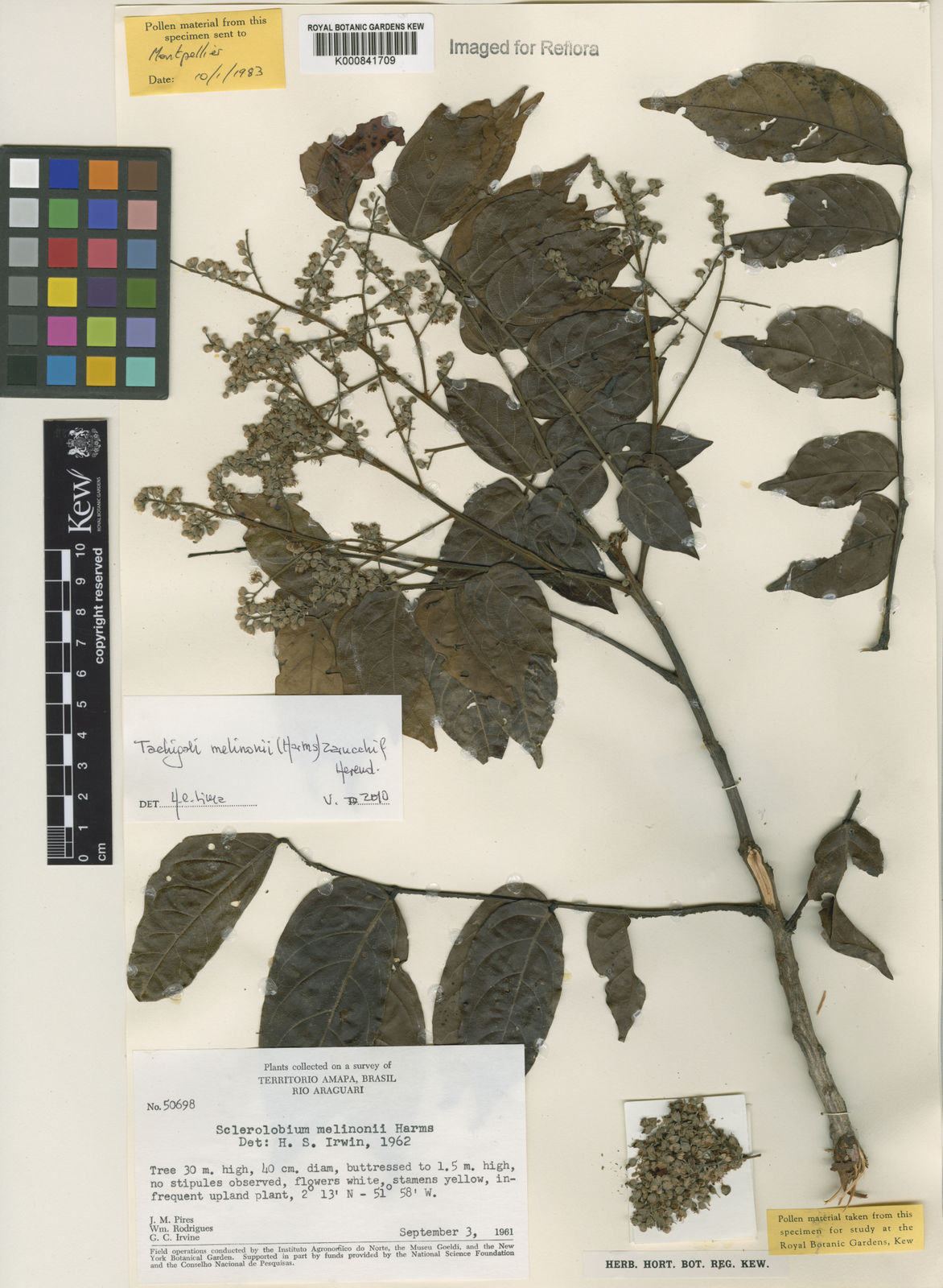unknown
tachigali melinonii
Also known as: []
Overview
A tropical tree species native to Central and South America, known for its ecological significance in forest ecosystems.
Benefits & Perks
["wildlife attractant (bees, butterflies, birds)","shade tolerant"]
Botanical Classification
| Phylum: | Magnoliophyta |
| Class: | Magnoliopsida |
| Order: | Fabales |
| Family: | Fabaceae |
| Genus: | Tachigali |
| Botanical Name: | Tachigali melinonii |
Plant Characteristics
Basic Information
- Category: Trees
- Suitable Location: outdoor garden in tropical or subtropical regions
- Suitable For:
- Is Weed: No
- Allergenicity: low
Environmental Needs
- Climate: {"temperatureRange":"18–30°C"}
- Hardiness: {"zones":"9–11"}
- Misting: rarely required, only if ambient humidity is very low
- Drainage: Fast-draining to prevent waterlogging.
- Soil Type: Well-draining potting mix with added organic matter and perlite.
Maintenance Level
- Maintenance Level: very high
- Toughness Level: very high
- Pruning Frequency: Annually or as needed to control size and shape.
- Pruning Intensity: Moderate; remove up to one-third of growth if necessary.
Care Details
Ideal Sunlight Coverage:
Bright indirect light for 6–8 hours daily; adjust to partial shade during intense midday sun.
Sunlight Tolerance Tips:
Gradually acclimate to brighter light to avoid leaf burn; protect from direct afternoon sun; adjust placement based on indoor/outdoor conditions.
Care Requirements
Care Difficulty
expert onlymoderate
Sunlight
partial shade to full sun
Rotate plant for even light exposure; use sheer curtains to filter intense light; monitor for signs of sun stress.
Watering
every 7–10 days during growing season, reduce in winter
Water thoroughly until it drains from the bottom; allow soil to dry partially between waterings; avoid overwatering.
Soil
well-draining, loamy soil with organic matter
pH: Slightly acidic to neutral (pH 6.0–7.0).
Use a mix with good drainage; avoid heavy clay soils; refresh soil every 1–2 years.
Temperature
Prefers 65–85°F (18–29°C); tolerates mild fluctuations but avoid prolonged exposure to extremes.
Avoid placing near drafty windows; use a humidifier in dry conditions; monitor temperature changes.
Fertilizing
every 4–6 weeks during active growth
Fertilize only when actively growing; flush soil occasionally to prevent salt buildup; avoid overfertilizing.
Propagation
Methods
Stem cuttings in spring or early summer.
Step-by-Step Propagation Guide
- Take a healthy cutting.
- Apply rooting hormone.
- Plant in medium.
- Maintain humidity.
- Wait for roots.
Best Time: Spring or early summer when the plant is actively growing.
Environment
High humidity, indirect light, and warm temperatures (70–80°F).
Medium
Well-draining mix of peat and perlite or cactus mix.
Hormone
Recommended to promote root development.
Timeline
Roots develop in 4–8 weeks; establish in 3–6 months.
Tools Needed
Pruning shears, rooting hormone, small pots, misting spray bottle.
Quick Tips
Use healthy, non-flowering stems; maintain consistent moisture; provide bottom heat for faster rooting.
Pruning & Repotting
Pruning Guide
Method
Selective thinning and heading back to encourage bushier growth.
Pruning Plan
Remove dead or overgrown branches to maintain shape and encourage new growth.
Tools
Pruning shears, sterilizing solution, gloves.
Checklist
Sterilize tools; prune during dormancy; make clean cuts; dispose of clippings.
Repotting Guide
Best Season
Spring, before the active growing season begins.
Pot Size
Increase pot size by 2–3 inches in diameter.
Method
Remove plant gently; trim roots if needed; place in new pot with fresh soil; water lightly.
Suggestions
Repot every 2–3 years or when roots outgrow the pot; provides fresh soil and space for growth.
Checklist
Check root bound status; prepare new pot; use fresh soil; water after repotting.
Advanced Care Tips
Watering Mastery
Watering Checklist
Check soil moisture; water thoroughly; ensure drainage; adjust for season.
How to Apply Water Properly
Water directly at the root zone, ensuring even moisture distribution; water early in the morning to minimize evaporation; ensure excess water drains away to prevent waterlogging.
Watering Schedule Tips
Water deeply once the top inch of soil feels dry; reduce frequency in winter to prevent root rot.
Soil Improvement
Add perlite or sand for drainage; incorporate compost for fertility; ensure aeration with coarse materials.
Temperature Stress Management
Signs of Temperature Issues
Yellowing leaves, wilting, or leaf drop; stunted growth or bud drop in extreme conditions.
Cold Stress
Slows growth, causes leaf discoloration, and may lead to root damage in freezing temperatures.
Solution: Move to a warmer location; insulate roots with mulch; avoid cold drafts and sudden temperature drops.
Hot Stress
Leaf scorch, wilting, and dehydration; may drop leaves to conserve water.
Solution: Provide shade during peak heat; increase humidity; water more frequently but avoid waterlogging.
Fertilizing Guide
Fertilizing Checklist
Check growth phase; dilute fertilizer; apply to moist soil; rinse between feedings.
Fertilizing Method
Use balanced liquid fertilizer diluted to half strength every 4–6 weeks during growing season; cease in winter.
Common Problems & Solutions
Toxicity Warning
Cats
Non-toxicTachigali melinonii is not known to be toxic to cats. There are no reported cases of adverse effects in felines from exposure or ingestion of this plant.
⚡ Toxic If:
None
Dogs
Non-toxicTachigali melinonii is not known to be toxic to dogs. There are no reported cases of adverse effects in canines from exposure or ingestion of this plant.
⚡ Toxic If:
None
Humans
Non-toxicTachigali melinonii is not known to exhibit any toxic properties to humans. The plant has not been documented to cause any adverse physiological effects upon contact or ingestion.
⚡ Toxic If:
None
Frequently Asked Questions
Q: Is Tachigali melinonii suitable for indoor cultivation?
A: No, it is a large tropical tree requiring outdoor conditions.
Q: Does this plant have any medicinal uses?
A: Unknown, further research is needed.
Q: How fast does Tachigali melinonii grow?
A: It is a slow-growing tree species.
Quick Reference
| Family: | Fabaceae |
| Care: | expert only |
| Light: | partial shade to full sun |
| Water: | every 7–10 days during growi |
Get Expert Care Tips
Download the Plantious app for personalized care reminders and plant identification!
Google Play App Store






